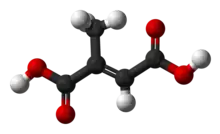Mesaconic acid
Mesaconic acid is one of several isomeric carboxylic acids obtained from citric acid. It is a colorless solid.
 | |
 | |
| Names | |
|---|---|
| Preferred IUPAC name
(2E)-2-Methylbut-2-enedioic acid | |
| Identifiers | |
3D model (JSmol) |
|
| 3DMet | |
| ChEBI | |
| ChemSpider | |
| ECHA InfoCard | 100.007.146 |
| EC Number |
|
| KEGG | |
PubChem CID |
|
| UNII | |
CompTox Dashboard (EPA) |
|
| |
| |
| Properties | |
| C5H6O4 | |
| Molar mass | 130.10 g/mol |
| Density | 1.31 g/cm3 |
| Melting point | 204 to 205 °C (399 to 401 °F; 477 to 478 K) |
| Boiling point | 250 °C (482 °F; 523 K) (decomposes) |
| Hazards | |
| GHS labelling: | |
 | |
| Warning | |
| H315, H319, H335 | |
| P261, P264, P271, P280, P302+P352, P304+P340, P305+P351+P338, P312, P321, P332+P313, P337+P313, P362, P403+P233, P405, P501 | |
Except where otherwise noted, data are given for materials in their standard state (at 25 °C [77 °F], 100 kPa).
Infobox references | |
Synthesis and reactions
It is prepared from citric acid, which is first converted to itaconic anhydride by dehydration and decarboxylation. Itaconic acid anhydride is isomerized to citraconic anhydride, which is hydrolyzed and the resulting acid further isomerized under acid-catalysis to give mesaconic acid.[1]
Hydration of mesaconic acid, a conversion catalyzed by mesaconyl-C4-CoA hydratase, gives citramalic acid.[2]
History
This acid was studied for the first time by Jacobus H. van 't Hoff in 1874.[3] It was later shown to be produced by Clostridium tetanomorphum. Further studies showed that this organic compound is involved in the biosynthesis of vitamin B12. It is a competitive inhibitor of fumarate reduction.[4][5]
The compound has been considered as a renewable precursor to the commodity chemical methacrylic acid.[6]
References
- R. L. Shriner; S. G. Ford; L. J. Roll (1931). "Mesaconic Acid". Org. Synth. 11: 74. doi:10.15227/orgsyn.011.0074.
- Berg, Ivan A. (2011). "Ecological Aspects of the Distribution of Different Autotrophic CO 2 Fixation Pathways". Applied and Environmental Microbiology. 77 (6): 1925–1936. Bibcode:2011ApEnM..77.1925B. doi:10.1128/AEM.02473-10. PMC 3067309. PMID 21216907.
- "Mesaconic acid". Archived from the original on November 17, 2005. Retrieved September 8, 2005.
- "Barker, Horace Albert". The Stadtman Way: The Story of Two Biochemists at NIH. Office of NIH History. Retrieved December 21, 2011.
- Switzer, Robert L.; Stadtman, Earl R.; Stadtman, Thressa C. (2004). "H.A. Barker". Biographical Memoirs. National Academies Press. 84: 3–22. PMID 15484416. Retrieved December 21, 2011.
- Santosh K. Yadav; Kevin M. Schmalbach; Emre Kinaci; Joseph F. Stanzione III; Giuseppe R. Palmese (2018). "Recent advances in plant-based vinyl ester resins and reactive diluents". European Polymer Journal. 98: 199–215. doi:10.1016/j.eurpolymj.2017.11.002.